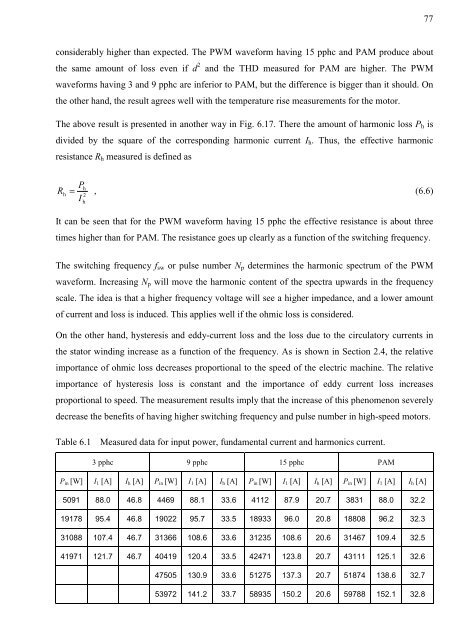Design and Voltage Supply of High-Speed Induction - Aaltodoc
Design and Voltage Supply of High-Speed Induction - Aaltodoc
Design and Voltage Supply of High-Speed Induction - Aaltodoc
Create successful ePaper yourself
Turn your PDF publications into a flip-book with our unique Google optimized e-Paper software.
considerably higher than expected. The PWM waveform having 15 pphc <strong>and</strong> PAM produce about<br />
the same amount <strong>of</strong> loss even if d 2 <strong>and</strong> the THD measured for PAM are higher. The PWM<br />
waveforms having 3 <strong>and</strong> 9 pphc are inferior to PAM, but the difference is bigger than it should. On<br />
the other h<strong>and</strong>, the result agrees well with the temperature rise measurements for the motor.<br />
The above result is presented in another way in Fig. 6.17. There the amount <strong>of</strong> harmonic loss Ph is<br />
divided by the square <strong>of</strong> the corresponding harmonic current Ih. Thus, the effective harmonic<br />
resistance Rh measured is defined as<br />
Ph<br />
R h = ,<br />
(6.6)<br />
2<br />
I<br />
h<br />
It can be seen that for the PWM waveform having 15 pphc the effective resistance is about three<br />
times higher than for PAM. The resistance goes up clearly as a function <strong>of</strong> the switching frequency.<br />
The switching frequency fsw or pulse number Np determines the harmonic spectrum <strong>of</strong> the PWM<br />
waveform. Increasing Np will move the harmonic content <strong>of</strong> the spectra upwards in the frequency<br />
scale. The idea is that a higher frequency voltage will see a higher impedance, <strong>and</strong> a lower amount<br />
<strong>of</strong> current <strong>and</strong> loss is induced. This applies well if the ohmic loss is considered.<br />
On the other h<strong>and</strong>, hysteresis <strong>and</strong> eddy-current loss <strong>and</strong> the loss due to the circulatory currents in<br />
the stator winding increase as a function <strong>of</strong> the frequency. As is shown in Section 2.4, the relative<br />
importance <strong>of</strong> ohmic loss decreases proportional to the speed <strong>of</strong> the electric machine. The relative<br />
importance <strong>of</strong> hysteresis loss is constant <strong>and</strong> the importance <strong>of</strong> eddy current loss increases<br />
proportional to speed. The measurement results imply that the increase <strong>of</strong> this phenomenon severely<br />
decrease the benefits <strong>of</strong> having higher switching frequency <strong>and</strong> pulse number in high-speed motors.<br />
Table 6.1 Measured data for input power, fundamental current <strong>and</strong> harmonics current.<br />
3 pphc 9 pphc 15 pphc PAM<br />
Pin [W] I1 [A] Ih [A] Pin [W] I1 [A] Ih [A] Pin [W] I1 [A] Ih [A] Pin [W] I1 [A] Ih [A]<br />
5091 88.0 46.8 4469 88.1 33.6 4112 87.9 20.7 3831 88.0 32.2<br />
19178 95.4 46.8 19022 95.7 33.5 18933 96.0 20.8 18808 96.2 32.3<br />
31088 107.4 46.7 31366 108.6 33.6 31235 108.6 20.6 31467 109.4 32.5<br />
41971 121.7 46.7 40419 120.4 33.5 42471 123.8 20.7 43111 125.1 32.6<br />
47505 130.9 33.6 51275 137.3 20.7 51874 138.6 32.7<br />
53972 141.2 33.7 58935 150.2 20.6 59788 152.1 32.8<br />
77
















